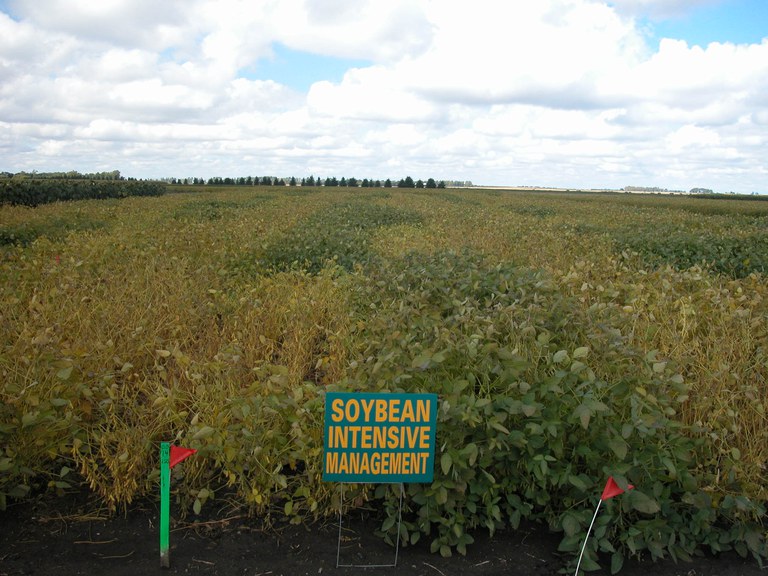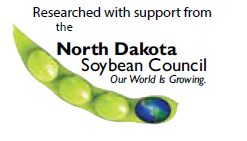Selected Management Factors for Economically Increasing Soybean Yield (A1718, Revised Jan. 2019)
Availability: Web only

About 3.8 million acres of soybeans were planted in North Dakota in 2008. That number reached 6.9 million acres in 2018. The growth in acreage can be attributed to the relative ease in producing the crop and its profitability.
Fluctuating weather, with varied rainfall amounts and stored soil moisture levels, requires soybean growers to make careful decisions on the tillage system, fertility management, variety selection, seedbed preparation, weed control strategies, rotations and soybean pest management practices.
Opportunities exist for farmers to increase soybean yield and profitability by improving plant establishment practices. Also, numerous special inputs that may add to soybean profits are being marketed.
A study was conducted by NDSU with selected intensive management practices and inputs to examine potential increases in yield and profit.
Materials and Methods
Nine research trials were conducted during a four year period at the NDSU Carrington Research Extension Center and research sites in Prosper and Fargo to examine inputs that potentially could increase soybean seed yield and profitability. The trials at Carrington were conducted on dryland conditions during year one and under irrigation during the entire study period. Trials were conducted at Prosper during year two and three, and in untiled and tiled environments at Fargo during the fourth year of the study.
The agronomic response of early and late-maturing varieties was examined using the production factors of planting rates, row spacings and special foliar inputs. Two Roundup Ready varieties, with maturity group ranges of 0.0 to 0.2 and 0.6 to 0.8, were planted each year (Table 1). Also, two planting dates were examined at Carrington in year one.

Planting rates were 150,000 and 200,000 pure live seeds (pls)/acre. Row spacings were 14 and 28 inches. Special foliar inputs included: 1) TJ Technologies micronutrient mix “Sunflower/Canola/Soybean” at 48 fluid ounces (fl oz)/acre plus Novozyme LCO Promoter (experimental product used in the first year and “Ratchet” at 4 fl oz/acre during the rest of the study) during second- to third-trifoliate (V2 to V3) growth stages and 2) BASF fungicide “Headline” at 6 fl oz/acre + NIS at 0.125 percent volume/volume during flowering to early pod development (R2 to R3) growth stages.
Other best management practices were used for soybean production during the study. Seed was inoculated with Bradyrhizobium japonicum.
Results and Discussion
The study’s average early season (two to four weeks after planting) established soybean plant density was 130,500 plants/acre with the planting rate of 150,000 pls/acre and 163,800 plants/acre with 200,000 pls/acre (Table 2). The percentage of established plants compared with planting rate was 87 percent with the low planting rate and 82 percent with the high planting rate.

Table 3 indicates soybean seed yield with row spacings, planting rates and special foliar inputs for each trial. Averaged across the nine trials, the study indicates the following yield advantages:

• 1.4 bushels (bu)/acre with 14-inch versus 28-inch rows
• 1.4 bu/acre with planting 200,000 pls/acre versus 150,000 pls/acre
• 2.2 bu/acre with special foliar inputs versus untreated check
Assumptions used for determining net revenue after costs of research factors include $10/bu soybean market price; no difference in costs between row spacings; 30 cents/1,000 seeds with 10 percent additional seed used to reach desired pls/acre; total cost of $32/acre for special foliar inputs plus $5/acre for a field application cost. Averaged across the nine trials, the study indicates the following revenue advantages:
• $14/acre with 14-inch vs. 28-inch rows
• $3/acre with the low vs. high planting rate
• $15/acre without special foliar inputs
The Fargo research site compared soybean performance with tiled and untiled conditions using controlled drainage structures (Table 4).

Early vigor was slightly greater, plants were taller and iron chlorosis expression was slightly lower in the tiled treatment. Seed yield with tiled was 13 percent higher than untiled yield.
Soybean yield was 2.6 bu/acre (5 percent) greater with the later maturity group (50.5 bu/acre), compared with the early maturity group (47.9 bu/acre). The highest yield with the combination of maturity groups and row spacing was with the later-maturing varieties grown in 14-inch rows (Table 5).

Table 6 displays average date of canopy closure, lowest pod height, and yield with row spacing and planting rates.

Averaged across seven trials, canopy closure with 14-inch rows was 35 days earlier, compared with 28-inch rows. The early canopy closure with the narrow rows provided the opportunity for increased capture of sunlight, increased crop competitiveness with weeds, decreased soil moisture loss from evaporation and ultimately yield increase, compared with the wide rows.
Canopy closure occurred sooner with 14-inch rows but was similar between planting rates. Pod height generally increased slightly with the high planting rate. Yield was highest with 14-inch rows and the high planting rate.
Soybean yield and net revenue after costs of research factors with the combination of row spacing, planting rates and special foliar inputs are listed in Table 7. The highest yield was obtained with foliar inputs in 14-inch rows at both planting rates and in 28-inch rows at the high planting rate. However, the combination of 14-inch rows and 150,000 pls/acre planting rate without foliar inputs provided the highest net revenue.

Summary
• Soybean yield increased with 14-inch versus 28-inch rows, 200,000 versus 150,000 pls/acre planting rate and special foliar inputs. The narrow rows also had higher net revenue than 28-inch rows. However, the low planting rate and no foliar inputs provided higher net revenue after costs of research factors versus the alternative choice for each factor.
• While several combinations of the three main factors in the study provided high yields, the combination of 14-inch rows and the 150,000 pls/acre planting rate without foliar inputs provided the highest net revenue after costs of research factors.
• While using pure live seed as a basis for reaching a targeted plant population is recommended, also consider that an additional 10 to 20 percent seedling loss can occur between planting and emergence.
• Management strategies that reduce the time required from planting to canopy closure will increase yield potential. This study indicated that canopy closure with narrow rows occurred more than a month earlier than with wide rows.
NDSU Extension does not endorse commercial products or companies even though reference may be made to trade names, trademarks or service names.
Photos by Greg Endres and Hans Kandel

Revised January 2019

